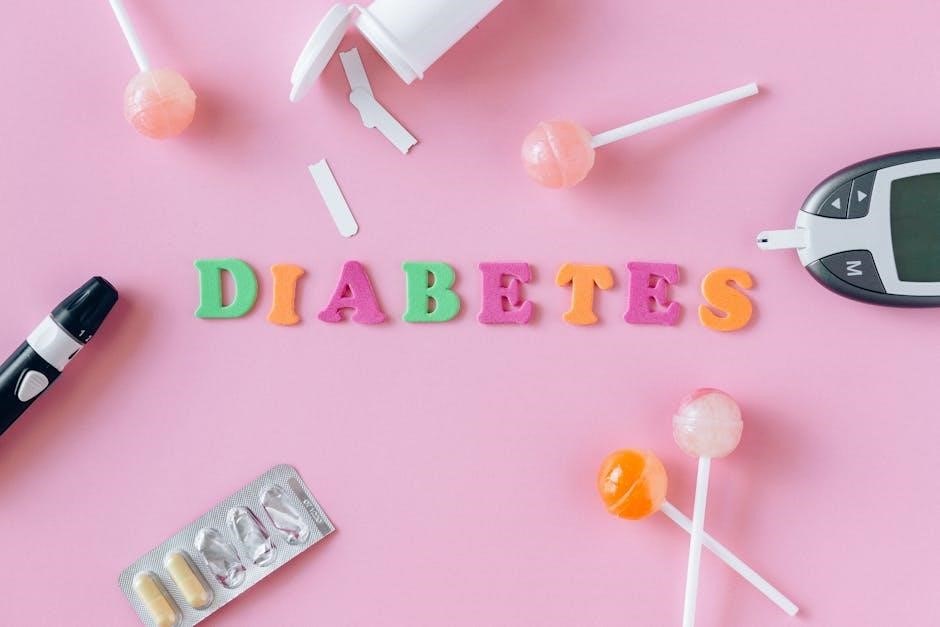Leptin is a hormone produced by fat cells that plays a crucial role in regulating energy balance and metabolism. It signals the brain about hunger, controlling food intake and appetite; This hormone is essential for maintaining weight and metabolic health, influencing how the body manages energy storage and expenditure.
1.1 What is Leptin?
Leptin is a hormone primarily produced by fat cells (adipocytes) in the body. It plays a central role in energy balance and body weight regulation by signaling the brain about the body’s fat storage status. Leptin is often referred to as the “satiety hormone” because it helps control hunger and appetite by sending signals to the hypothalamus, the part of the brain that regulates food intake and metabolism. When leptin levels are high, it indicates that the body has enough stored energy, which reduces hunger and increases energy expenditure. Conversely, low leptin levels signal the body to eat more to replenish energy stores. Leptin also influences insulin sensitivity and metabolic rate, making it a key player in overall metabolic health. Its discovery has revolutionized the understanding of obesity and weight management, as it highlights the complex interplay between hormones, appetite, and energy balance. Leptin’s role extends beyond hunger regulation, impacting processes like inflammation, immune function, and reproductive health, further emphasizing its importance in maintaining overall well-being.
1.2 Role of Leptin in Metabolism
Leptin plays a vital role in metabolism by helping the body decide whether to store or burn fat. It acts as a signaling molecule, informing the brain about the body’s energy status. When leptin levels are high, it signals the brain to reduce appetite and increase energy expenditure, promoting fat breakdown. Conversely, low leptin levels trigger the brain to increase hunger and conserve energy, often leading to fat storage.
Leptin influences metabolic rate by regulating the hypothalamus, a key area of the brain that controls energy balance. It ensures that the body maintains a stable weight by adjusting how calories are used or stored. Additionally, leptin impacts insulin sensitivity, which is crucial for glucose metabolism. Proper leptin function helps prevent metabolic disorders, such as obesity and type 2 diabetes.
Leptin levels are directly linked to body fat percentage. More body fat typically means higher leptin levels, while less body fat results in lower levels. However, in some cases, such as obesity, the body may develop leptin resistance, where the brain fails to respond effectively to leptin signals. This can disrupt metabolism and lead to further weight gain.
Overall, leptin is a cornerstone of metabolic regulation, ensuring the body efficiently manages energy and maintains a healthy weight. Its proper function is essential for overall metabolic health and prevents conditions associated with energy imbalance.
1.3 How Leptin Affects Hunger and Appetite
Leptin plays a pivotal role in regulating hunger and appetite by acting as a signaling hormone. Produced by fat cells, leptin communicates with the hypothalamus in the brain, which is the central hub for appetite control. When leptin levels are high, it signals the brain that the body has sufficient energy stores, thereby reducing hunger and increasing feelings of satiety. Conversely, when leptin levels drop, the brain interprets this as a signal that energy stores are low, triggering hunger and encouraging food intake to restore balance.
This hormone not only influences appetite but also modulates metabolism to maintain energy balance. Low leptin levels can lead to increased hunger and overeating, while high leptin levels suppress appetite and promote weight loss. However, leptin resistance, where the brain fails to respond to leptin signals, can disrupt this process, leading to excessive hunger and weight gain.
Understanding how leptin affects hunger and appetite is crucial for developing strategies to manage weight and improve metabolic health. By supporting healthy leptin function, individuals can better regulate their food intake and maintain a balanced energy system.

Leptin Diet Plan Overview
The Leptin Diet Plan focuses on optimizing leptin function to support weight management and metabolic health. It emphasizes balanced nutrition, portion control, and meal timing to enhance leptin sensitivity, helping regulate hunger, energy, and fat storage effectively for sustainable weight loss and improved overall well-being.
2.1 What is the Leptin Diet?
The Leptin Diet is a dietary approach designed to optimize leptin function, a hormone crucial for appetite regulation and metabolism. It focuses on maintaining healthy leptin levels to enhance weight management and metabolic health. The diet emphasizes balanced nutrition, with recommendations to eat nutrient-dense foods that support leptin sensitivity, such as lean proteins, healthy fats, and fiber-rich vegetables. It advises avoiding highly processed foods and excessive carbohydrates that may disrupt leptin balance. By incorporating these dietary guidelines, the Leptin Diet aims to regulate hunger signals, improve energy levels, and promote sustainable weight loss. Additionally, it may involve lifestyle changes, such as adequate sleep and stress management, to further support leptin function and overall well-being.
2.2 Key Principles of the Leptin Diet
The Leptin Diet is built on several core principles designed to support leptin function and overall metabolic health. One of the primary principles is emphasizing protein-rich foods, as protein helps maintain muscle mass and supports leptin production. Healthy fats, such as those found in avocados, nuts, and olive oil, are also prioritized, as they promote satiety and hormone balance. The diet encourages a focus on whole, unprocessed foods, including vegetables, lean meats, and whole grains, while minimizing intake of refined carbohydrates and sugary foods that can disrupt leptin signaling.
Another key principle is portion control and mindful eating, which help avoid overeating and maintain a healthy caloric intake. The diet also emphasizes the importance of meal timing, suggesting that eating larger meals earlier in the day and smaller meals in the evening may help regulate leptin levels. Additionally, staying hydrated and avoiding excessive alcohol consumption are recommended to support optimal metabolic function. By adhering to these principles, the Leptin Diet aims to create a balanced and sustainable eating plan that promotes weight management and improves overall health.
2.3 How the Leptin Diet Works
The Leptin Diet operates by optimizing the body’s leptin hormone function, which plays a central role in energy balance and metabolism. By focusing on nutrient-dense foods, the diet aims to stabilize leptin levels, reducing hunger cravings and improving metabolic efficiency. The diet emphasizes protein-rich foods, healthy fats, and fiber, which help regulate blood sugar and maintain satiety.
One of the key mechanisms is the reduction of insulin resistance, which is closely linked to leptin function. By limiting refined carbohydrates and sugary foods, the diet helps prevent spikes in blood sugar, promoting a more stable insulin response. This, in turn, supports leptin sensitivity, allowing the body to more effectively signal when it has consumed enough calories.

Additionally, the Leptin Diet encourages portion control and mindful eating, which helps avoid overeating and supports a balanced caloric intake. The diet also promotes regular meal timing, with an emphasis on eating nutrient-dense meals throughout the day to maintain energy levels and prevent excessive hunger. By aligning with the body’s natural leptin signaling, the diet aims to create a sustainable approach to weight management and overall health.
Overall, the Leptin Diet works by addressing the root causes of metabolic dysfunction, focusing on hormone balance, and providing a structured yet flexible eating plan that fosters long-term health benefits.

Benefits of the Leptin Diet
The Leptin Diet offers multiple benefits, including weight loss, improved insulin sensitivity, and enhanced energy levels. It helps regulate appetite, reducing hunger and cravings, and supports overall metabolic health by balancing leptin levels, leading to a more sustainable and healthy lifestyle.
3.1 Weight Loss Potential
The Leptin Diet holds significant promise for weight loss by targeting the hormone leptin, which plays a central role in energy balance and metabolism. By optimizing leptin levels, the diet helps the body more efficiently burn fat and reduce fat storage. This approach focuses on regulating hunger signals, improving metabolic function, and enhancing the body’s ability to shed unwanted pounds. The diet emphasizes nutrient-dense foods and portion control, which support leptin sensitivity and promote a healthier relationship with food. Unlike traditional calorie-restriction diets, the Leptin Diet aims to sustain weight loss by addressing the hormonal imbalances that often hinder progress. Studies suggest that individuals who follow the Leptin Diet experience noticeable reductions in body fat, particularly in stubborn areas like the abdomen. Additionally, the diet’s focus on balanced eating habits helps maintain weight loss over the long term, making it a sustainable option for those seeking to improve their overall health and physique. By aligning with leptin’s natural functions, the diet offers a scientifically grounded method for achieving and maintaining a healthy weight.

3.2 Improved Insulin Sensitivity

The Leptin Diet is particularly effective at enhancing insulin sensitivity, which is crucial for maintaining healthy blood sugar levels and preventing conditions like type 2 diabetes. By focusing on nutrient-dense, whole foods and avoiding refined carbohydrates, the diet helps regulate glucose metabolism and improve the body’s response to insulin. Leptin plays a key role in this process by signaling the brain and other tissues to respond appropriately to insulin, ensuring that glucose is efficiently utilized or stored. When leptin levels are balanced, the body is better equipped to manage blood sugar fluctuations, reducing the risk of insulin resistance. This is especially beneficial for individuals who struggle with metabolic syndrome or prediabetes. The diet’s emphasis on protein-rich foods, healthy fats, and fiber further supports insulin sensitivity by slowing down carbohydrate digestion and preventing sharp spikes in blood sugar. Over time, these dietary changes can lead to improved pancreatic function and a reduced reliance on medication for blood sugar control. By addressing leptin levels and insulin sensitivity simultaneously, the Leptin Diet offers a comprehensive approach to metabolic health that goes beyond traditional diet plans.
3.3 Enhanced Energy Levels
The Leptin Diet is designed to optimize leptin function, which directly impacts energy levels. Leptin plays a crucial role in energy balance by signaling the brain about the body’s energy stores. When leptin levels are balanced, the body is better equipped to regulate metabolism, leading to sustained energy throughout the day. By focusing on whole, nutrient-dense foods and avoiding high-carbohydrate, high-sugar meals, the Leptin Diet helps stabilize blood sugar levels, preventing energy crashes and fatigue. This approach also supports the body’s natural fat-burning processes, ensuring that energy is derived from stored fat rather than relying on constant carbohydrate intake.

Moreover, the diet’s emphasis on protein and healthy fats helps maintain muscle mass and supports adrenal function, both of which are essential for maintaining energy. By reducing inflammation and improving insulin sensitivity, the Leptin Diet further enhances mitochondrial function, the body’s energy-producing powerhouses. Over time, individuals on the Leptin Diet often report feeling more vibrant and experiencing fewer midday slumps, which can significantly improve overall quality of life and productivity. The diet’s focus on leptin optimization ensures that energy levels are not just temporary but are part of a broader metabolic health strategy.
3.4 Better Appetite Control
The Leptin Diet is specifically designed to help individuals achieve better appetite control by balancing leptin levels. Leptin, often referred to as the “satiety hormone,” plays a key role in signaling the brain when the body has consumed enough food, thereby reducing hunger and preventing overeating. When leptin levels are optimal, the body is better equipped to regulate appetite naturally, leading to a reduction in cravings and portion sizes.
The diet focuses on reducing inflammation and insulin resistance, both of which can disrupt leptin signaling. By eliminating processed foods, refined sugars, and unhealthy fats, the Leptin Diet helps restore the body’s natural ability to regulate hunger and satiety. Incorporating protein-rich foods, healthy fats, and fiber-rich vegetables supports the production of leptin and other hormones that control appetite. This approach not only helps individuals feel fuller for longer but also reduces the likelihood of impulsive snacking.
Additionally, the Leptin Diet emphasizes the importance of meal timing and portion control, which further aids in stabilizing hunger hormones. By avoiding high-carbohydrate and high-sugar foods, the diet prevents sudden spikes in blood sugar that can lead to increased hunger and cravings. Over time, followers of the Leptin Diet often report feeling more in control of their eating habits, making it easier to maintain a healthy weight and improve overall metabolic health.
- Balanced leptin levels reduce hunger and cravings.
- Focus on whole, nutrient-dense foods to stabilize appetite.
- Avoid processed and high-sugar foods that disrupt leptin signaling.
- Strategic meal timing and portion control support long-term appetite management.
By addressing the root causes of appetite dysregulation, the Leptin Diet provides a sustainable solution for better appetite control, leading to healthier eating habits and improved overall well-being.

Leptin Diet Food List
The Leptin Diet focuses on nutrient-dense foods that support leptin function. It includes lean proteins, healthy fats, and fiber-rich vegetables. Avoid processed foods, refined sugars, and unhealthy fats that disrupt leptin signaling and appetite regulation. This approach promotes balanced eating for optimal metabolic health.
4.1 Foods to Eat on the Leptin Diet
The Leptin Diet emphasizes whole, nutrient-dense foods that support leptin function and overall metabolic health. Focus on incorporating lean proteins like chicken, turkey, and fish, which help maintain muscle mass and regulate hunger. Healthy fats, such as avocados, nuts, and olive oil, are also essential for satiety and hormone production.
Vegetables are a cornerstone of the diet, with an emphasis on non-starchy options like leafy greens (spinach, kale), broccoli, and bell peppers. These provide fiber, vitamins, and minerals while keeping calorie intake balanced. Fresh fruits, such as berries and apples, are included in moderation due to their natural sugars and fiber content.
Whole grains like quinoa, brown rice, and oats are recommended in controlled portions to provide sustained energy without causing insulin spikes. Fermented foods, such as yogurt and kimchi, support gut health, which is closely linked to leptin function and appetite regulation.
Portion control is key, as overeating can disrupt leptin signaling. Meals should be balanced, combining protein, healthy fats, and complex carbohydrates to maintain energy levels and satisfaction. Avoiding processed foods, sugary snacks, and excessive carbohydrates is crucial to support leptin health and weight management.
4.2 Foods to Avoid on the Leptin Diet
The Leptin Diet advises eliminating or significantly reducing certain foods that can disrupt leptin function and hinder weight management. Sugary foods and refined carbohydrates, such as white bread, pastries, and sweetened beverages, should be avoided as they can cause insulin spikes and negatively impact leptin signaling.
Processed foods, often high in unhealthy fats and added sugars, are also discouraged. These foods can lead to inflammation and metabolic issues, which may impair leptin balance. Additionally, excessive consumption of saturated fats, particularly from fried foods and fatty meats, should be limited to protect leptin function and overall health.
Alcohol consumption should be kept to a minimum, as it can interfere with metabolism and hormone levels. Foods high in empty calories, such as sugary snacks and beverages with little nutritional value, should also be avoided to prevent overeating and metabolic disruptions.
By focusing on whole, nutrient-dense foods and avoiding those that can lead to insulin resistance and inflammation, individuals can better support leptin balance and achieve their weight management goals. Portion control and regular, balanced meals are also crucial for maintaining healthy leptin levels and overall metabolic health.

4.3 Portion Control Guidelines
Portion control is a critical aspect of the Leptin Diet, as it helps maintain leptin balance and prevents overeating. The diet emphasizes eating until satisfied, not stuffed, to avoid overwhelming the body with excess calories. Using smaller plates can help visually manage portion sizes, making it easier to gauge appropriate amounts of food.
Eating mindfully is another key guideline. This involves eliminating distractions during meals, such as turning off the TV, to focus on the food and better recognize hunger and fullness cues. Listening to the body’s signals ensures that meals are neither too large nor too small, supporting metabolic health.
Measuring or estimating food portions can also be helpful, especially for high-calorie or dense foods like fats and carbohydrates. Avoiding distractions while eating and stopping when full are essential practices to prevent overconsumption. Additionally, balancing macronutrients in each meal helps maintain energy levels and supports leptin function.
Regular, balanced meals throughout the day are encouraged to avoid extreme hunger, which can lead to overeating. By adhering to these portion control guidelines, individuals can better manage their calorie intake, support leptin balance, and achieve sustainable weight management. This approach fosters a healthier relationship with food and promotes long-term metabolic well-being.
4.4 Meal Timing Strategies
Meal timing plays a significant role in the Leptin Diet, as it helps regulate leptin levels and support metabolic function. Eating meals at consistent times throughout the day can help stabilize energy levels and prevent drastic fluctuations in hunger and satiety hormones. One key strategy is to include a protein-rich breakfast within an hour of waking up, as this helps jumpstart metabolism and maintain leptin sensitivity.
Spacing meals evenly throughout the day is also recommended. This approach prevents extreme hunger, which can lead to overeating and disrupt leptin balance. Including a balance of protein, healthy fats, and fiber in each meal helps slow digestion, keeping leptin levels stable and reducing cravings. Avoiding late-night meals is another important guideline, as eating too close to bedtime can interfere with leptin signaling and metabolic health during sleep.
Additionally, the Leptin Diet encourages listening to the body’s natural hunger and fullness cues rather than adhering to a strict schedule. This flexible approach helps maintain a healthy relationship with food and prevents stress-related eating. Staying hydrated throughout the day is also emphasized, as thirst can sometimes be mistaken for hunger, leading to unnecessary snacking.
By incorporating these meal timing strategies, individuals can better support leptin function, leading to improved hunger control, sustained energy levels, and overall metabolic health. Consistency and mindfulness are key to maximizing the benefits of the Leptin Diet.

Sample Leptin Diet Meal Plan
A sample Leptin Diet meal plan includes high-protein breakfasts, balanced lunches, and light dinners. Breakfast options like eggs or Greek yogurt with berries are suggested. Lunches feature lean meats or fish with vegetables, while dinners focus on whole grains and healthy fats. Portion control and meal timing are emphasized.
5.1 Breakfast Options
Breakfast is a crucial meal on the Leptin Diet, as it helps kickstart metabolism and set the tone for the day. Ideal breakfast options focus on protein-rich foods, healthy fats, and minimal carbohydrates to maintain leptin balance. Eggs are a popular choice, whether scrambled, boiled, or made into an omelet with vegetables like spinach or mushrooms. Greek yogurt, especially full-fat and unsweetened, paired with fresh berries or a sprinkle of chia seeds, provides a satisfying and nutrient-dense start. Cottage cheese is another excellent option, as it is high in protein and low in carbs, making it ideal for appetite control.
Avocado is also a great addition to breakfast, either on its own or as a topping for eggs or whole-grain toast. Smoked salmon with a side of lettuce or tomato is another delicious and protein-packed choice. Nuts and seeds, such as almonds or flaxseeds, can be added in moderation for crunch and extra nutrition. Beverages like green tea or black coffee are recommended to complement the meal and boost metabolism. Avoid sugary foods, juices, and refined grains, as they can disrupt leptin function and lead to energy crashes. By emphasizing protein and healthy fats, these breakfast options help regulate hunger and support weight management goals.
5.2 Lunch Ideas
Lunch on the Leptin Diet should be balanced, focusing on protein, healthy fats, and minimal carbohydrates to support leptin function and metabolic health. Grilled chicken or fish, such as salmon or cod, are excellent protein sources that can be paired with a variety of non-starchy vegetables like broccoli, spinach, or bell peppers. These options are nutrient-dense and help regulate appetite.
A fresh salad with mixed greens, avocado, and a lean protein like turkey or tofu is another ideal choice. Dressings should be low in sugar and made with healthy fats like olive oil or avocado oil. Nuts or seeds, such as almonds or pumpkin seeds, can be added in moderation for crunch and extra nutrition. For those preferring hot meals, a stir-fry made with vegetables like cauliflower, zucchini, and mushrooms, cooked in coconut oil or olive oil, is a flavorful and leptin-friendly option.
Beef or turkey burgers (without the bun) are also a great choice, as they provide high-quality protein and can be served with a side of roasted vegetables or a small salad. Vegetarian options might include tofu or legumes, paired with fresh greens and a drizzle of olive oil. Avoid sugary condiments, refined grains, and high-carb sides, as they can interfere with leptin sensitivity. Staying hydrated with water or herbal tea is also recommended to support overall health and digestion.
Portion control is key, and meals should be balanced to ensure sustained energy levels and appetite regulation. Incorporating a small amount of healthy fats, such as avocado or nuts, can enhance satiety and provide essential nutrients. By focusing on whole, unprocessed foods, the Leptin Diet promotes better leptin function and long-term weight management.
